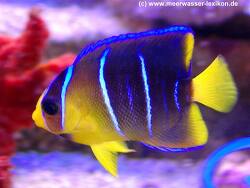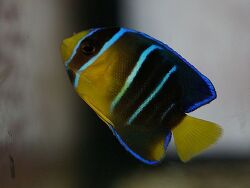Info
Holacanthus bermudensis Goode, 1876
Holacanthus bermudensis also known as the Blue Angelfish or Corn Sugar is found in the Gulf of Mexico, Florida, quite rare in Bermuda and the Bahamas. Inhabit shallow waters to depths up to 60 meters.
The Blue Angelfish is very similar to the Queen angelfish, Holacanthus ciliaris, they differ primarily in color pattern. Juveniles are dark blue with a yellow tail, a yellow area around the pectoral fins, and brilliant blue vertical bars on the body. The adult Blue Angelfish has a greenish-blue body and tail. The tail has yellow rear edge, while in the closely related queen angelfish (Holacanthus ciliaris) has an all yellow tail. Holacanthus bermudens is hermaphroditic but there are no distinguishing markings that differentiate males from females.
In the wild the Blue Angelfish eats mainly sponges with small amounts of algae, tunicates, and corals. Holacanthus bermudensis survives in captivity mainly on sponges so make sure you can get the right food with sponge in it.
Holacanthus bermudensis is best kept as the only angelfish in the tank. Not a good reef dweller, may eat some soft corals and nip at large Polyped stony corals, zooanthids and clams. Smaller specimens are les.
Synonymised names
Angelichthys isabelita Jordan & Rutter, 1898 · unaccepted (synonym)
Holacanthus ciliaris bermudensis Goode, 1876 · unaccepted
Holacanthus isabelita (Jordan & Rutter, 1898) · unaccepted
Holocanthus bermudensis Goode, 1876 · unaccepted (misspelling)
Holacanthus bermudensis also known as the Blue Angelfish or Corn Sugar is found in the Gulf of Mexico, Florida, quite rare in Bermuda and the Bahamas. Inhabit shallow waters to depths up to 60 meters.
The Blue Angelfish is very similar to the Queen angelfish, Holacanthus ciliaris, they differ primarily in color pattern. Juveniles are dark blue with a yellow tail, a yellow area around the pectoral fins, and brilliant blue vertical bars on the body. The adult Blue Angelfish has a greenish-blue body and tail. The tail has yellow rear edge, while in the closely related queen angelfish (Holacanthus ciliaris) has an all yellow tail. Holacanthus bermudens is hermaphroditic but there are no distinguishing markings that differentiate males from females.
In the wild the Blue Angelfish eats mainly sponges with small amounts of algae, tunicates, and corals. Holacanthus bermudensis survives in captivity mainly on sponges so make sure you can get the right food with sponge in it.
Holacanthus bermudensis is best kept as the only angelfish in the tank. Not a good reef dweller, may eat some soft corals and nip at large Polyped stony corals, zooanthids and clams. Smaller specimens are les.
Synonymised names
Angelichthys isabelita Jordan & Rutter, 1898 · unaccepted (synonym)
Holacanthus ciliaris bermudensis Goode, 1876 · unaccepted
Holacanthus isabelita (Jordan & Rutter, 1898) · unaccepted
Holocanthus bermudensis Goode, 1876 · unaccepted (misspelling)







 Pauline Walsh Jacobson, USA
Pauline Walsh Jacobson, USA





















